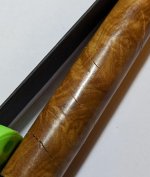rendauphin
Full Member
I turned a Leveche rollerball using a Brown Mallee Burr blank. I used epoxy to glue the blank to the tube and after bringing into the house for a couple of days cracks appeared along some of the burr lines. I finished it using Phil's melamine technique.
Any advice to prevent this much appreciated.
Jim

Any advice to prevent this much appreciated.
Jim

